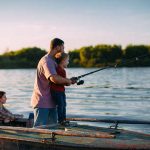1. Introduction to Fish Stocking and Habitat Restoration
Fish stocking and habitat restoration are two important conservation efforts widely practiced throughout the United States. These activities play a vital role in maintaining healthy fish populations, supporting recreational fishing, and preserving aquatic ecosystems for future generations.
What is Fish Stocking?
Fish stocking involves releasing hatchery-raised fish into rivers, lakes, or ponds. This is done to boost local fish populations, support recreational angling, and sometimes to restore native species that have declined due to overfishing, pollution, or habitat loss.
Main Goals of Fish Stocking
| Goal | Description |
|---|---|
| Increase Fish Populations | Enhance numbers where natural reproduction is low |
| Support Recreation | Provide more fishing opportunities for anglers |
| Restore Native Species | Bring back species that have disappeared from certain waters |
What is Habitat Restoration?
Habitat restoration means improving or repairing streams, rivers, lakes, and wetlands so that fish and other wildlife can thrive. This might include planting native plants along riverbanks, removing barriers like old dams, or adding rocks and logs to create better places for fish to hide and spawn.
Main Goals of Habitat Restoration
| Goal | Description |
|---|---|
| Improve Water Quality | Reduce pollution and erosion by restoring natural vegetation |
| Create Healthy Habitats | Build environments where fish can breed, feed, and grow |
| Support Biodiversity | Help many different species live together in balance |
The Significance in U.S. Conservation Efforts
Both fish stocking and habitat restoration are key parts of U.S. conservation strategies. They help balance ecological needs with the interests of local communities and outdoor enthusiasts. Many state wildlife agencies, nonprofits, and volunteers work together on these projects to ensure American waters remain vibrant and full of life for years to come.
2. Why These Projects Matter in the U.S.
Ecological Benefits
Fish stocking and habitat restoration projects play a big role in keeping American waterways healthy. By introducing native fish species and improving rivers, lakes, and streams, these efforts help balance local ecosystems. Healthy fish populations support a food chain that includes birds, mammals, and even people. Restoring habitats also fights erosion, cleans water naturally, and brings back plants that are vital for wildlife.
Recreational Value
Fishing is more than just a pastime in the U.S.—it’s a tradition for millions of families. Stocking programs make sure there are enough fish for anglers to catch, whether it’s trout in Pennsylvania streams or bass in Texas lakes. Restored habitats mean better access and experiences for everyone who loves spending time outdoors. In many communities, these projects keep fishing spots open and enjoyable for generations.
Economic Impact
Fish stocking and habitat restoration also boost local economies. The fishing industry—both recreational and commercial—creates jobs and brings visitors to towns near popular lakes and rivers. Money spent on licenses, bait, gear, boats, guides, and lodging adds up fast. Check out the table below for a quick look at how these activities benefit American communities:
| Benefit | Description | Example Locations |
|---|---|---|
| Tourism & Recreation | Attracts anglers from across the country | Great Lakes region, Florida Keys |
| Job Creation | Supports businesses like tackle shops and guides | Montana fly-fishing towns, Gulf Coast marinas |
| Community Revenue | Local events and tournaments generate funds | Bassmaster events in Alabama, trout festivals in Colorado |
| Healthy Ecosystems | Lowers costs for water treatment by improving natural filtration | Sacramento River (California), Chesapeake Bay (Maryland/Virginia) |
Cultural Importance Across America
From Native American traditions to modern sportfishing tournaments, fish stocking and habitat work connect people with nature and each other. Waterways like the Mississippi River or Lake Erie are part of local identity. By joining these projects, Americans help ensure their favorite fishing holes stay vibrant for years to come.

3. Ways to Get Involved as a Volunteer or Angler
If you’re interested in making a positive impact on America’s fisheries, getting involved in fish stocking and habitat restoration projects is a great way to start. Whether you’re an experienced angler or just someone who cares about your local waterways, there are plenty of ways to participate across the U.S.
How to Find Local Projects
Many organizations host volunteer events and ongoing programs for both adults and families. Here are some of the main types of groups that organize these activities:
| Organization | Type of Projects | How to Get Involved |
|---|---|---|
| State Fish & Wildlife Agencies | Fish stocking, stream cleanups, habitat monitoring | Check agency websites for volunteer sign-ups and event calendars |
| Trout Unlimited | Habitat restoration, stream surveys, educational workshops | Join a local chapter or attend public events listed online |
| Bass Anglers Sportsman Society (B.A.S.S.) | Stocking programs, youth fishing clinics, conservation days | Participate through local clubs or by contacting regional reps |
| Ducks Unlimited and Other Conservation Groups | Wetland restoration, native planting, water quality testing | Sign up as a volunteer on their websites or social media pages |
| U.S. Forest Service & National Park Service | Streambank stabilization, invasive species removal, citizen science projects | Look for “volunteer” sections on their official sites for opportunities near you |
Common Roles You Can Take On
No matter your skill level or background, there are roles for everyone:
- Fish Stocking Helper: Assist with transporting and releasing fish into lakes and streams.
- Stream Cleanup Crew: Remove litter and debris from riverbanks and aquatic habitats.
- Citizen Scientist: Collect data on water quality or fish populations with simple tools provided by the organizers.
- Youth Mentor: Help teach kids about fishing ethics and conservation at community events.
- Native Plant Volunteer: Plant trees and shrubs along waterways to improve habitat and prevent erosion.
When and Where to Volunteer?
You can find projects year-round, but spring and fall are especially popular times for fish stocking and planting native vegetation. Most states have event calendars online. Many projects take place in state parks, national forests, city lakes, or even private lands with special access agreements.
Helpful Tips for First-Timers
- No gear? No problem! Most groups provide basic equipment like gloves, waders, and tools.
- No experience needed. Organizers will show you what to do—just bring a good attitude!
- Bring family or friends. Many events welcome kids and make it a fun learning experience for all ages.
- Dress for the weather. Wear sturdy shoes, sun protection, and clothes that can get dirty or wet.
- If you’re an angler: Volunteering is also a great way to meet other local fishermen and learn new spots while giving back to the resource you love.
Ready to Get Started?
The first step is reaching out! Visit your state’s fish & wildlife website or connect with local chapters of conservation groups. You’ll find lots of welcoming folks ready to help you make a difference in America’s waters.
4. Best Practices and Responsible Participation
Tips for Effective and Ethical Involvement
Getting involved in fish stocking and habitat restoration projects across the U.S. can be both rewarding and impactful. To ensure your participation supports conservation goals and respects local ecosystems, it’s important to follow best practices tailored to American environments.
Understand Local Guidelines and Conservation Priorities
Before you join a project, research the specific state or federal guidelines for fish stocking and habitat restoration. The U.S. Fish and Wildlife Service (USFWS) and state departments like California Department of Fish and Wildlife or Texas Parks and Wildlife offer resources outlining which species are prioritized for protection, where stocking is allowed, and what restoration efforts are underway.
| Region | Key Agencies | Main Focus |
|---|---|---|
| Pacific Northwest | NOAA Fisheries, Oregon Dept. of Fish & Wildlife | Salmon habitat restoration, native trout stocking |
| Southeast | Florida Fish & Wildlife Conservation Commission | Mangrove restoration, largemouth bass stocking |
| Midwest | Minnesota Dept. of Natural Resources | Lakeshore improvement, walleye stocking |
| Northeast | Pennsylvania Fish & Boat Commission | Streambank stabilization, brook trout stocking |
Respect Native Ecosystems
Focus on projects that restore natural habitats or support native species. Avoid participating in activities that introduce non-native fish unless they are managed by state agencies with clear ecological goals. For example, many states have programs to remove invasive carp from rivers or replant native aquatic vegetation to improve water quality.
Example: Native Trout Restoration in Colorado
In Colorado, volunteers work with Colorado Parks and Wildlife to restore native cutthroat trout populations by removing non-native competitors and improving stream habitats. These projects help preserve regional biodiversity while supporting recreational fishing for future generations.
Follow Safe and Sustainable Practices
- Use approved gear: Always use decontaminated equipment to prevent spreading invasive species between waterways.
- Avoid disturbing wildlife: When working near nesting birds or spawning fish, keep noise and movement to a minimum.
- Report issues: If you spot pollution, illegal dumping, or signs of disease in stocked fish, notify local authorities immediately.
- Volunteer with reputable groups: Join organizations like Trout Unlimited, Ducks Unlimited, or local watershed alliances known for science-based approaches.
Stay Informed About Local Events and Opportunities
Many U.S. states run “Fish Stocking Days” or “Habitat Workdays.” Check community boards at bait shops, outdoor retailers like Bass Pro Shops, or websites such as TakeMeFishing.org to find events near you. Signing up for newsletters from conservation organizations can also keep you updated on volunteer opportunities.
5. Local Success Stories and Community Impact
Spotlight on Notable American Projects
Across the United States, fish stocking and habitat restoration projects have made a real difference for local communities, wildlife, and anglers alike. Here are some inspiring examples that show how these efforts come to life:
Case Study: Lake Havasu, Arizona
Lake Havasu is famous for its thriving bass population, thanks to a partnership between government agencies and local volunteers. Over the years, thousands of artificial fish habitats have been installed. This project not only boosted fish numbers but also made the lake a hotspot for fishing tournaments, supporting local businesses.
Case Study: Salmon Restoration in Washington State
Washington’s rivers are home to iconic salmon runs. Through habitat restoration—like removing old dams and planting native trees along riverbanks—communities have helped salmon populations recover. Local tribes, conservation groups, and schools work together, blending tradition with modern science.
Community-Led Trout Stocking in Pennsylvania
Pennsylvania is known for its trout streams. Each spring, community members of all ages gather to help stock trout in local creeks and rivers. These events bring people together, teach kids about conservation, and create traditions that last generations.
How Communities Benefit
| Project Type | Main Benefits | Who Gets Involved? |
|---|---|---|
| Bass Habitat Creation (e.g., Lake Havasu) | Better fishing, increased tourism, stronger local economy | Anglers, business owners, volunteers |
| Salmon Habitat Restoration (e.g., WA Rivers) | Wildlife recovery, cultural connection, healthier ecosystems | Tribes, students, conservationists |
| Trout Stocking Events (e.g., Pennsylvania) | Family fun, education, community pride | K-12 students, families, local clubs |
Real Voices from the Field
“Our annual trout stocking day is something the whole town looks forward to,” says Mary from rural Pennsylvania. “It gets kids outside and teaches them about nature.”
“Restoring our river has brought the salmon back—and brought our community closer,” shares David from Washington State.
Joining In Makes a Difference!
No matter where you live in the U.S., there’s likely a fish stocking or habitat restoration project near you. By getting involved, you help your local environment and create lasting memories with your community.


